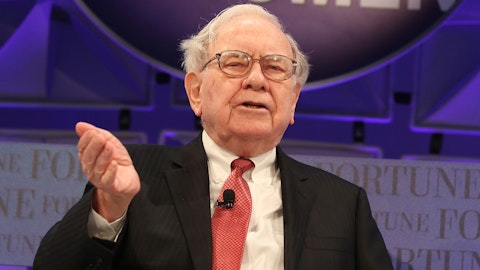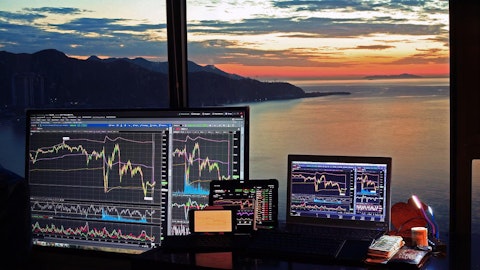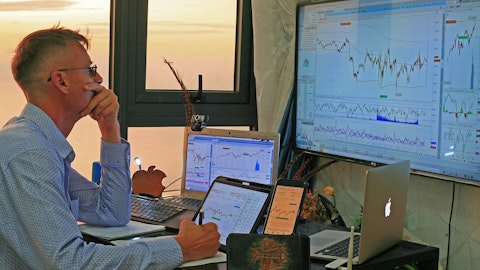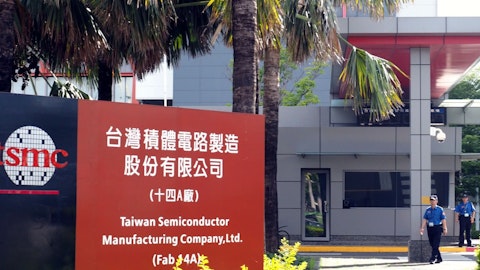Can we have more quantitative implication to TSMC? What is the dollar content per server or how big the addressable market for TSMC in 2025? Is the reason new AI or ChatGPT, the business already embedded in your long-term growth target, which is 15% to 20%? Or can we see some incremental upside?Jeff Su Okay. Bruce, thank you. So Bruce’s first question is around, I guess, AI and machine learning. He wants to know if we have any quantitative numbers to give in terms of, for example, dollar content — sorry, semiconductor content per server, dollar value or in terms of the addressable TAM. How do we see this growth of this market? And have we already embedded this into our forecast. Is that correct, Bruce?Bruce Lu That’s right.C. C. Wei Bruce, let me answer this question.
We certainly, we have observed an incremental increase in AI-related demand. It will also help the ongoing inventory digestion. The trend is very positive for TSMC. But today, if you ask me to quantitatively to say that how much of the amount increase or what is the dollar content in the server, it’s too early to say. It still continue to be developed. And ChatGPT right now reinforce the already strong conviction that we have in HPC and AI as a structurally megatrend for TSMC’s business growth in the future. Whether this one has been included in our previous announcement that said that we have a 15% to 20% CAGR, the answer is probably partly yes, because of — for [server] (ph), we have accelerated into our consideration. But this ChatGPT is a large language model is a new application.
And we haven’t really have a kind of a number that put into our CAGR. But is definitely, as I said, it really reinforced our already strong conviction that HPC and AI will give us a much higher opportunities in the future.Jeff Su Okay, Bruce. Does that answer your first question? Yes, sorry, go ahead.Bruce Lu Yes. Yes, I want to move on to a different topic, which is the cash dividend. I mean TSMC distribute like — dividend policy was 70% of the free cash flow. And we do see the free cash flow is getting stronger, especially CapEx growth rate is slower, especially for next year. Can we expect TSMC to maintain the dividend policy, which is 70% of the free cash flow next year? Or we would like to improve our balance sheet given the current rate hike environment.Jeff Su Okay.
Thank you, Bruce. So Bruce’s second question is around our cash dividend policy. He notes that in the past, we have said our cash dividend will be based on 70% of free cash flow distribution. But his question is, as our CapEx is slowing, our free cash flow is going stronger. Do we still adhere to 70% of free cash flow or because of the environment, are we more focused on, I think, Bruce, in terms of maintaining a — improving our balance sheet strength.Wendell Huang Okay, Bruce. This is Wendell. Let me make a few comments on the dividends. TSMC is committed to a sustainable and steadily increasing dividends. During the periods of high capital intensity or high capital investment, more of the focus is on sustainable. But when we start to capture and harvest the capital investment spend, the commitment is — or the focus is more towards steadily increasing.
The 70% ratio is a guidelines. Let me give you an example. If in the particular year, the free cash flow is much lower because of higher CapEx or lower profit than the — to maintain a sustainable dividend, the ratio of free cash flow to be dispersed could be higher. And on the other hand, in a year where free cash flow is particularly high, the ratio can be 70%, but it can be lower because we need to look forward into the year behind that specific year, and to make sure it is sustainable. Okay, does that answer your question?Bruce Lu Yes. Yes. But if we do see a comfortable range about the free cash flow, we still expect like reasonable high payout ratio, right?Wendell Huang Yes. Yes. As I said, the principle is 70%, but it has to be sustainable and steadily increasing.Bruce Lu I understand.Jeff Su Thank you, Bruce.
Operator, can we move on to the next participant, please.Operator Next one to ask questions, Randy Abrams from Credit Suisse.Randy Abrams I wanted to ask a question just on the CapEx in 2 parts. First, as you look at the 3-nanometer where you mentioned supply still short of demand and have a lot of applications coming in. Do you have plans for potential reuse of 5-nanometer in the next 1 to 2 years as you bring up more of the 3-nanometer? And then the second part of the question, I wanted to ask more on that Kaohsiung fab shift. If you could go through why the plan to pull back on 28. And then with the intention for where you would shift that investment. Because I know you did cancel the 7-nanometer for that line. So if you could discuss the change you’re making to Kaohsiung and does it affect the timing to ramp that fab?Jeff Su Okay.
Thank you, Randy. So Randy’s first question is kind of related to our CapEx and capacity plan. His question partly is in terms of C.C. noted that the N3 demand exceeds our ability to supply. So he’s asking, will we consider to reuse or convert tools — N5 tools to N3 in the next few years. And also, he wants to know related to our plans in Kaohsiung. What is the thinking or the reasoning for pulling back on the 28-nanometer expansion in Kaohsiung..C. C. Wei Okay, Randy. You got a very good question about whether we converted some of the N5’s capacity to N3 because N3 today, we are short of support to our customer. Instead of saying the convert N5 capacity to N3, let me say that we developed a strategy and a methodology to make some of the N3’s tool can be supported by N5.
And we take this kind of flexibility into our consideration so that we can fulfill our commitment to support our customer in N3 as much as possible. Although still not enough, but we are doing that. So that answer one of your — the first part of your question. You asked about Kaohsiung’s TAM. Let me say that we look at the market situation today, and we are going to build — initially the 28 nanometers that demand is so high so that we have to put Kaohsiung into our consideration. However, the market situation is so dynamic, and we look at our plan. One of the plan is in Japan, we build a new fab for 28 nanometers of specialty. By the way, TSMC expand the mature node’s capacity or for specialties. We don’t increase capacity just for pure logic application.
The other one, no, we don’t do. So in order to avoid some of the overcapacity. So we built 1 in Japan. We’re also expanding our capacity, 28-nanometer capacity in Nanjing. That’s the second one. And then we are considering of the euro. That might be the third one for automotive application. Put all 3 together, we don’t think today that Kaohsiung’s — if we build 28-nanometer probably, it won’t be kind of financially feasible. So we diverted now adjusted to become a more advanced node, which we are still in shortage. And Kaohsiung is so close to Tainan so that we can have more flexibility in between. Randy, did that answer your question?Randy Abrams Yes. No, that’s helpful. It sounds like it will be very much advanced capacity than like the 5, 3 and below.
And just — maybe I have one follow-up on the first question is on the CapEx framework. With the expectation second half kind of rebound with the share gains comes through considering the new nodes more capital-intensive, should we think of this CapEx having an up direction as we look ahead to next year?Jeff Su Okay. So Randy, I’ll allow this to be a follow-up, but Randy’s question is basically, well, considering the second half business will be stronger. I think, Randy, basically, you’re asking, we have provided the guidance range of between $32 billion to $36 billion. Are you asking could that be upside or revised higher, is that correct?Randy Abrams Yes, more the framework into next year since this is more kind of prudent management, a bit recessionary.Wendell Huang Randy, let me answer that.
As we stated before, every year, our CapEx is spent for the opportunities in the future years. So although there are short-term cyclicality in the industry, but we believe if the structural long-term demand is there, and the future opportunities is there, and we will continue to invest. That will be the framework that we can provide to you.Jeff Su Okay, Randy. You have a quick second question.Randy Abrams Yes, I’ll do the quick second. So for 2-nanometer, if you could clarify the ramp, do you expect this steep ramp to be in 2025? Or is it more 2026? And do you also view that ramp being much more with the SOIC, the back-end integration throughput?Jeff Su Okay. So Randy, second question is on 2-nanometer. We have said volume production in 2025.
Will the large volume be in ’25 or ’26 as part of this question. And does this mean you will go hand-in-hand, I guess, with SoIC and advanced packaging?C. C. Wei Randy, let me answer the question. 2-nanometer technology definitely will start to ramp in 2025. And you asked about the volume. The volume in 2023 certainly is much higher than 2025 because 2025 is the year. But saying that, I mean that we are having HPC customer and the smartphone customer now engaged with N2 and what we’ll be ramping up in 2025. Now whether it’s related to CHIPS Act or not, it depends on customers’ product and their plan. And today, I don’t have — I cannot share with you all those kind of minor details because it’s related to customer’s product plan.Jeff Su Okay.
Thank you, Randy. Operator, can we move on to the next participant, please?Operator The next one to ask question, Charlie Chan from Morgan Stanley.Charlie Chan C.C., Wendell and Jeff, so first of all, congrats for the first quarter gross margin and great to hear that N3E continue to improve. So let me stay with the CapEx question for a little bit as my first question. So first of all, the major equipment supplier ASML, to suggest that EUV orders get pushed out a little bit. And we all know that your company is a major user of EUV. So can anyone answer the question? First of all, whether the CapEx this year will be lower end of your guidance range? And also for next year, whether your CapEx intensity would decline year-on-year given that EUV push out?Jeff Su Okay.




